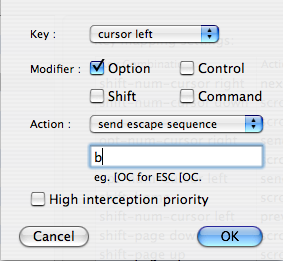
- ITERM KEYBOARD SHORTCUTS HOW TO
- ITERM KEYBOARD SHORTCUTS CODE
- ITERM KEYBOARD SHORTCUTS PLUS
- ITERM KEYBOARD SHORTCUTS WINDOWS
Optionally, if you still want to use option instead of ctrl + shift, you can use option + ⟵ and option + ⟶ when assigning the keyboard shortcut to jump words and option + delete when assigning the keyboard shortcut for deleting words.
ITERM KEYBOARD SHORTCUTS CODE
Then for the Action select Send Hex Code and use the code 17 in the field.
ITERM KEYBOARD SHORTCUTS HOW TO
Then, in the Action dropdown, select Send Escape Sequence and enter the same letter ( b or f) as the keyboard shortcut you entered.ĭo it for the other key and that’s all there is to it! How To Assign Ctrl + Shift + Delete To Delete Whole WordsĪssign a keyboard shortcut, in the same way as above, and use ctrl + shift + delete as the Keyboard Shortcut. In the Keyboard Shortcut field, push the keys ctrl + shift + b or ctrl + shift + f and you should see something like ^⬆︎B or ^⬆︎F. Select the + button at the bottom to add a new shortcut. To assign the shortcut open the iTerm preferences and choose the keys tab. How To Use Ctrl + Shift + f and Ctrl + Shift + b To Jump Words If you don’t use those keyboard shortcuts they will take time to get used to, but I like them particularily because I don’t have to lift my hands off of home row to reach the arrow keys. If you use ctrl + b and ctrl + f to navigate cursor, I recommend give these steps a try. I found this to be easier to use given the placement of capslock (which should be your ctrl!) and shift on the keyboard, compared to option. You can choose from a variety of actions - including ' swap position.
ITERM KEYBOARD SHORTCUTS PLUS
On the bottom you will find a plus sign - press it to add a keyboard shortcut. Click on pane to swap to There is no keyboard shortcut for this according to gitlab issue. I’m already used to using ctrl + f and ctrl + b to move the cursor forward and backward in terminal and, instead of option, decided to give ctrl + shift a try. Right-click pane to swap from, it turns red. I tried it for a while and found the option key to be placed in such a weird position on the Apple keyboards that I wouldn’t use option and often forget about it while in the “programming zone”. See the list of key binding actions at Preferences > Profiles > Keys.I really feel like I’m missing out on being able to jump words when working in terminal and found some blogs on how to do it by using option. Settings here are overridden by those in a profile's key mappings. This interface works like the keyboard shortcut system in profiles (described above) but it affects all profiles. You can then add the custom button to your touch bar with View > Customize Touch Bar. By pressing this button, you can define a new custom touch bar button with any of the actions you can assign to a key (see below). This button is only visible if your OS version supports touch bars. For more information, see Hotkey Windows.

Sets up a new hotkey window profile if you don't already have one.
This requires that you enable access for assistive devices in the Universal Access panel of System Preferences. If it is the foreground app, it will be sent to the back. From then on, pressing that keystroke (even when iTerm2 is not the front application) will cause iTerm2 to come to the front. When enabled, you can focus the Hotkey: field and press a keystroke.
ITERM KEYBOARD SHORTCUTS WINDOWS
Show/Hide iTerm2 all windows with a system-wide hotkey This only affects switching panes, tabs, and windows by keyboard as configure in the preceding settings. If your keyboard layout requires you to hold Shift (or some other modifier) to press a number, enable this to treat the top row of keys as number keys even when Shift is not pressed. Windows are normally navigated with cmd+opt+number, but you can change the modifier used for that function here. Tabs are normally navigated with cmd+number, but you can change the modifier used for that function here.

This is useful, for example, if you find it difficult to press "option" for "meta" and would prefer to use "command" for that purpose.

ITerm2 allows you to change the meanings of the modifier keys only within iTerm2.


 0 kommentar(er)
0 kommentar(er)
